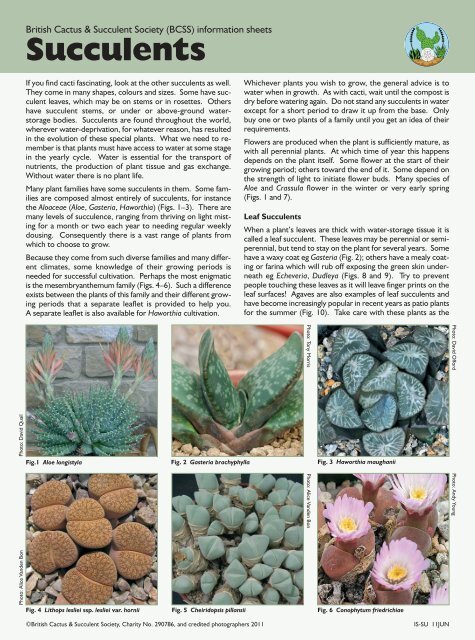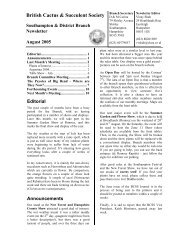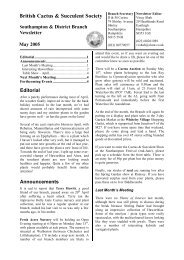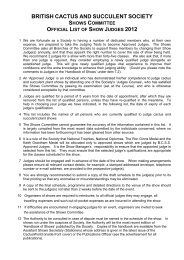Succulents - British Cactus & Succulent Society
Succulents - British Cactus & Succulent Society
Succulents - British Cactus & Succulent Society
You also want an ePaper? Increase the reach of your titles
YUMPU automatically turns print PDFs into web optimized ePapers that Google loves.
<strong>British</strong> <strong>Cactus</strong> & <strong>Succulent</strong> <strong>Society</strong> (BCSS) information sheets<strong><strong>Succulent</strong>s</strong>If you find cacti fascinating, look at the other succulents as well.They come in many shapes, colours and sizes. Some have succulentleaves, which may be on stems or in rosettes. Othershave succulent stems, or under or above-ground waterstoragebodies. <strong><strong>Succulent</strong>s</strong> are found throughout the world,wherever water-deprivation, for whatever reason, has resultedin the evolution of these special plants. What we need to rememberis that plants must have access to water at some stagein the yearly cycle. Water is essential for the transport ofnutrients, the production of plant tissue and gas exchange.Without water there is no plant life.Many plant families have some succulents in them. Some familiesare composed almost entirely of succulents, for instancethe Aloaceae (Aloe, Gasteria, Haworthia) (Figs. 1–3). There aremany levels of succulence, ranging from thriving on light mistingfor a month or two each year to needing regular weeklydousing. Consequently there is a vast range of plants fromwhich to choose to grow.Because they come from such diverse families and many differentclimates, some knowledge of their growing periods isneeded for successful cultivation. Perhaps the most enigmaticis the mesembryanthemum family (Figs. 4–6). Such a differenceexists between the plants of this family and their different growingperiods that a separate leaflet is provided to help you.A separate leaflet is also available for Haworthia cultivation.Whichever plants you wish to grow, the general advice is towater when in growth. As with cacti, wait until the compost isdry before watering again. Do not stand any succulents in waterexcept for a short period to draw it up from the base. Onlybuy one or two plants of a family until you get an idea of theirrequirements.Flowers are produced when the plant is sufficiently mature, aswith all perennial plants. At which time of year this happensdepends on the plant itself. Some flower at the start of theirgrowing period; others toward the end of it. Some depend onthe strength of light to initiate flower buds. Many species ofAloe and Crassula flower in the winter or very early spring(Figs. 1 and 7).Leaf <strong><strong>Succulent</strong>s</strong>When a plant’s leaves are thick with water-storage tissue it iscalled a leaf succulent. These leaves may be perennial or semiperennial,but tend to stay on the plant for several years. Somehave a waxy coat eg Gasteria (Fig. 2); others have a mealy coatingor farina which will rub off exposing the green skin underneatheg Echeveria, Dudleya (Figs. 8 and 9). Try to preventpeople touching these leaves as it will leave finger prints on theleaf surfaces! Agaves are also examples of leaf succulents andhave become increasingly popular in recent years as patio plantsfor the summer (Fig. 10). Take care with these plants as thePhoto: David QuailFig.1 Aloe longistylaFig. 2 Gasteria brachyphyllaPhoto: Tony Morris Photo: Alice Vanden BonFig. 3 Haworthia maughaniiPhoto: David OffordPhoto: Andy YoungPhoto: Alice Vanden BonFig. 4 Lithops lesliei ssp. lesliei var. horniiFig. 5 Cheiridopsis pillansiiFig. 6 Conophytum friedrichiae©<strong>British</strong> <strong>Cactus</strong> & <strong>Succulent</strong> <strong>Society</strong>, Charity No. 290786, and credited photographers 2011IS-SU 11JUN
leaf tips can be very sharp. Pieces of polystyrene or wine corksare useful for pushing on the end of the leaf to prevent damageif there are children or pets in the vicinity.Stem <strong><strong>Succulent</strong>s</strong>To make the most of any water around, a plant has to store asmuch as possible while reducing the natural loss through leaves.This is the strategy adopted by the stem succulents. Often youwill find their stems beautifully marked and examples of this arefound in the Euphorbiaceae (Euphorbia) (Fig. 11) and theAsclepiadaceae such as Stapelia and Huernia (Figs. 12 and 13).The production of a tuber or caudex above ground is a specialcase of stem succulence. These succulents are called caudiciforms.Some of these plants have the potential to grow intolarge shrubs and trees and most growers choose smaller orslow-growing species which are better suited to a windowsill orgreenhouse environment. They can be potted to display thecaudex above ground but care must be taken to ensure that thetuber does not get burnt on a hot day as this can damage theplant. Caudiciforms are not specific to one family and examplesare found in many different plant families. A popular, smallergrowing, caudiciform, which you will frequently find on theBCSS seed list is Dioscorea elephantipes (the elephants foot),(Fig. 14). This is a member of the Dioscoreaceae. Otherexamples of caudex growing plants suitable for the windowsillor greenhouse are species of Adenium and Pachypodium(Apocynaceae), Dorstenia (Moraceae), Fockea (Asclepiadaceae),Ipomoea (Convolvulaceae) and Pelargonium and Sarcocaulon(Fig. 15), (Geraniaceae).Photo: Alice Vanden BonPhoto: John PilbeamPhoto: Alice Vanden BonFig. 7 Crassula mesembrianthemopsisFig. 8 Echeveria runyoniiFig. 9 Dudleya pachyphytumPhoto: John PilbeamPhoto: Alice Vanden BonPhoto: Alice Vanden BonFig. 10 Agave titanotaFig. 11 Euphorbia obesaFig. 12 Stapelia giganteaPhoto: Alice Vanden BonPhoto: Tony MorrisPhoto: Bill WeightmanFig. 13 Huernia oculataFig. 14 Caudex of Dioscorea elephantipesFig. 15 Sarcocaulon herrei
















